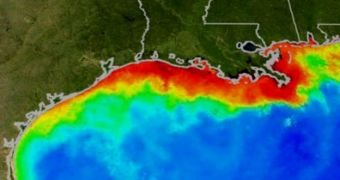Experts in the United States anticipated that this year's Gulf of Mexico dead zone will be the largest ever recorded. The phenomenon's usual spread will be augmented by the Mississippi River floods that scarred the central United States earlier this year.
University of Michigan aquatic ecologist Donald Scavia and his team believe that the floods will have a catastrophic effect on Gulf of Mexico waters in the area where the Mississippi flows into the ocean.
The experts say that the massive amounts of dirt, chemicals, nutrients and other products that the waters carry will contribute to algal blooms in the area. The microscopic organisms will then grow out of control, starving the water of all available oxygen.
In turn, this will lead to the creation of a dead zone, where oxygen levels are simply too low to allow for the existence of complex lifeforms, such as fish, dolphins and so on. The animals that will not be killed as the dead zone forms will flee for their lives.
Official statistics from the US National Oceanic and Atmospheric Administration (NOAA), published in a new report on June 14, indicate that, once fully formed, the dead zone will cover an area about the size of New Hampshire, or between 8,500 and 9,421 square miles.
Comparatively, the average spread of the Gulf of Mexico dead zone for the past 5 years has been 6,000 square miles. “Stream flows were nearly double normal during May, delivering massive amounts of nutrients to the Gulf, and that's what drives the dead zone,” Scavia explains.
The expert holds an appointment as the Special Counsel to the U-M President for Sustainability, as the director of the Graham Sustainability Institute, and also as a professor at the School of Natural Resources and Environment at the university.
“While there is some uncertainty regarding the size, position and timing of this year's hypoxic zone in the Gulf, the forecast models are in overall agreement that hypoxia will be larger than we have typically seen in recent years,” NOAA Administrator Jane Lubchenco explains.
At this point, the experts say, fertilizers and livestock waste are the most dangerous debris the waters carry. They contain a lot of nitrogen and phosphorus, chemicals that oxygen-consuming organisms thrive on, but which cannot be handled by more complex creatures.
The latest US Geological Survey (USGS) data indicates that more than 164,000 metric tons of nitrogen made their way into the Gulf waters over the month of Mary alone. These amounts are no less than 35 percent higher than normal.
“Yes, the floodwaters really matter, but the fact that there's so much more nitrogen in the system now than there was back in the '60s is the real issue. The growth of these dead zones is an ecological time bomb,” Scavia explains.
“Without determined local, regional and national efforts to control them, we are putting major fisheries at risk,” he concludes.

 14 DAY TRIAL //
14 DAY TRIAL //